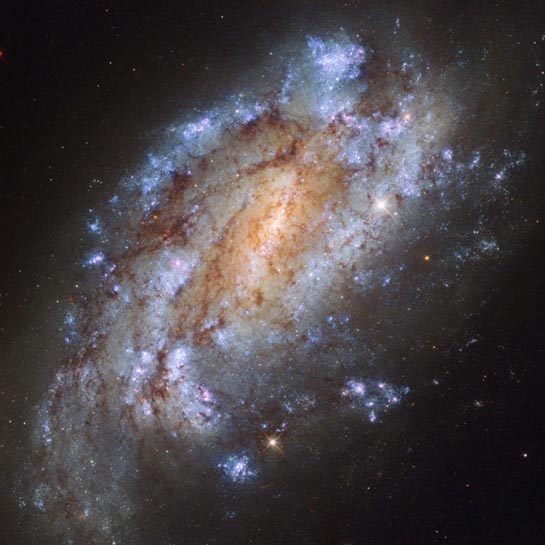
Spiral Galaxy
RA 4h 17m 37.33s Dec -62° 47' 4.65"
Reticulum
50 million light years
11.0
3.5 × 2.0 arcmin
2.33 x 2.28 arcminutes
North is 72.6° left of vertical
ESA/Hubble & NASA
February 5, 2018
2005 Image: G0527
ABOUT THIS IMAGE:
Roughly 50 million light-years away lies a somewhat overlooked little galaxy named NGC 1559. Pictured here by Hubble's Wide Field Camera 3, this barred spiral lies in the little-observed southern constellation of Reticulum (The Reticule). It was first discovered by James Dunlop on November 6, 1826.
NGC 1559 has massive spiral arms chock-full of star formation, and is receding from us at a speed of about 1300 km/s. The galaxy contains the mass of around ten billion Suns - while this may sound like a lot, that is almost 100 times less massive than the Milky Way. Although NGC 1559 appears to sit near one of our nearest neighbors in the sky - the Large Magellanic Cloud (LMC), this is just a trick of perspective. In reality, NGC 1559 is physically nowhere near the LMC in space - in fact, it truly is a loner, lacking the company of any nearby galaxies or membership of any galaxy cluster.
Despite its lack of cosmic companions, when this lonely galaxy has a telescope pointed in its direction, it puts on quite a show! NGC 1559 has hosted a variety of spectacular exploding stars called supernovae, four of which we have observed - in 1984, 1986, 2005, and 2009 (SN 1984J, 1986L, 2005df [a Type Ia], and 2009ib [a Type II-P, with an unusually long plateau]).
NGC 1559 may be alone in space, but we are watching and admiring from far away.
From Wikipedia:
NGC 1559 is a barred spiral galaxy in the constellation Reticulum. It is also a Seyfert galaxy. Although it was originally thought to be a member of the Dorado Group, subsequent observations have shown that it is in fact not a member of any galaxy group or cluster and does not have any nearby companions. NGC 1559 has massive spiral arms and strong star formation. It contains a small bar which is oriented nearly east-west and spans 40?. Its bar and disc are the source of very strong radio emissions.
In
2005, a Type 1a supernova, (SN 2005df) was observed. Two other supernovae
discovered in NGC 1559 were SN 1984J and SN 1986L. All three were discovered
by Australian amateur astronomer Robert Evans.